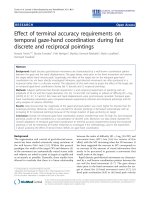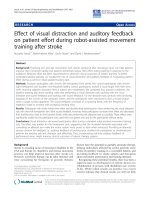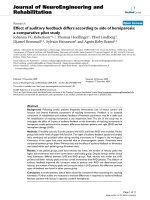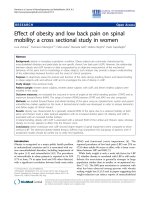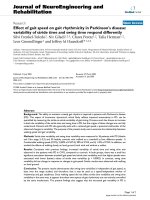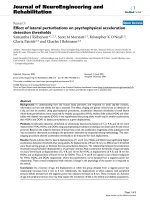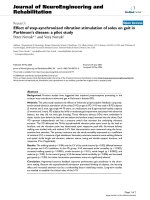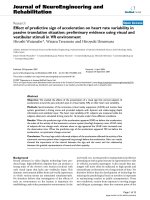báo cáo hóa học: " Effect of substrate (ZnO) morphology on enzyme immobilization and its catalytic activity" pptx
Bạn đang xem bản rút gọn của tài liệu. Xem và tải ngay bản đầy đủ của tài liệu tại đây (2.52 MB, 7 trang )
NANO EXPRESS Open Access
Effect of substrate (ZnO) morphology on enzyme
immobilization and its catalytic activity
Yan Zhang
1
, Haixia Wu
1*
, Xuelei Huang
2
, Jingyan Zhang
2
and Shouwu Guo
1*
Abstract
In this study, zinc oxide (ZnO) nanocrystals with different morphologies were synthesized and used as substrates
for enzyme immobilization. The effects of morphology of ZnO nanocrystals on enzyme immobilization and their
catalytic activities were investigated. The ZnO nanocrystals were prepared through a hydrothermal procedure using
tetramethylammonium hydroxide as a mineralizing agent. The c ontrol on the morphology of ZnO nanocrystals was
achieved by varying the ratio of CH
3
OH to H
2
O, which were used as solvents in the hydrothermal reaction system.
The surface of as-prepared ZnO nanoparticles was functionalized with amino groups using 3-
aminopropyltriethoxysilane and tetraethyl orthosilicate, and the amino groups on the surface were identified and
calculated by FT-IR and the Kaiser assay. Horseradish peroxidase was immobilized on as-modified ZnO
nanostructures with glutaraldehyde as a crosslinker. The results showed that three-dimensional nanomul tipod is
more appropriate for the immob ilization of enzyme used further in catalytic reaction.
Introduction
The composition, size, and surface characteristics of sub-
strates have been considered as the important factors that
affect the physical/chemical properties of the immobilized
enzymes [1-3]. However, for conventional bulk solid sub-
strates, such as glass slides [4], polymer monoliths [5,6],
and silica beads [3], the control on their morphologies and
functionalizing their surfaces are usually laborious. Nanos-
caled materials, such as metal [7] and metal oxide nano-
spheres [8], carbon nanotubes [9,10], graphene oxide
nanosheets [11], hav e also bee n utilized as the substrates
for enzyme immobilization. It has been demonstrated that
the size of nanostructured materials might play significant
roles to regulate the catalytic activity of the immobilized
enzymes [3]. The preparation of nanostructured materials
with controlled chemical composition, size, morphology,
and the surface functionalization have witnessed great pro-
gressive achievements during the last two decades [12,13].
However, the systematic study of the effects of the mor-
phology of the nanoscale substrates on the enzyme immo-
bilization remains to be expanded. ZnO nanocrystals have
unique physical/chemical properties and pronounced bio-
compatibility, which are benefic ial for many practical
applications. In addition, a variety of nanostructures of
ZnO, such as nanospheres [14], nanowires [15], nanorods
[16], nanonails [17], nanotubes [18], nanot etrapods [19] ,
nanotablets [20], and nanoflowers [21], have been pre-
pared successfully. Therefore, ZnO nanocrystals are ideal
materials to study the effect of the morphology of the sub-
strate on the catalytic efficiency of the immobilized
enzymes. Horseradish peroxidase (HRP) was used as a
model enzyme because it has been wildly studied and used
in many fields, such as organic syntheses [22], phenol
removal [23], biosensor, and drug delivery [24].
In this study, we report the effects of the morphology
of the ZnO nanocrystals on the enzyme immobilization.
ZnO nanocrystals with different morphologies , including
nanosphere, nanodisk, and nanomultipod, were fabri-
cated simply through a hydrothermal procedure. The
surface of ZnO nanocrystal was functionalized with the
amino groups using 3-aminopropyltriethoxysilane
(APTES) and tetraethyl orthosilicate (TEOS) [25]. Glutar-
aldehyde was used as a crosslinker to immobilize the
HRP enzyme molecules on the surface of as-modified
ZnO nanocrystals. Then the enzyme loading and catalytic
activity were evaluated.
* Correspondence: ;
1
National Key Laboratory of Micro/Nano Fabrication Technology, Key
Laboratory for Thin Film and Microfabrication of the Ministry of Education,
Research Institute of Micro/Nano Science and Technology, Shanghai Jiao
Tong University, Shanghai 200240, PR China
Full list of author information is available at the end of the article
Zhang et al. Nanoscale Research Letters 2011, 6:450
/>© 2011 Zhang et al; licensee Springer. This is an Open Access article distributed under the terms of the Creative Commons Attribution
License ( which permits unrestricted use, distrib ution, and reproduction in any medium,
provided the original work is properl y cited.
Results and discussion
ZnO nanocrystals with different morphology
Figure 1 shows the SEM images of ZnO nanocrystals
with different morphologies. The nanospheres, with dia-
meter of approximately 30 nm, were obtained when pure
methanol was used as the hydrothermal reaction solvent
as shown in Figure 1a. When the ratio of methanol to
water was adjust ed to 1:1, ZnO nanodiscs, app roximately
85 nm in width and 25 nm in thickness, were acquired as
shown in Figure 1b. Figure 1c shows the ZnO nanomulti-
pods composed of several rods of 100 nm in diameter
and 200 nm in length when the methanol/water ratio
reaches 1:9. This illustrates that the ratio of methanol/
water is certainly a crucial factor to control on the mor-
phology of ZnO nanocrystals. Although the morpholo-
gies of aforementioned ZnO nanocrystals are different,
the XRD patterns are all well consistent with the stan-
dard wurtzite ZnO structure as shown in Figure 2. Thus,
the effect of crystal form on the surface modification and
enzyme immobilization can be neglected.
Surface modification of ZnO nanocrystals
In order to immobilize enzyme, the surface of ZnO nano-
crystals were func tionalized with amino groups using
APTES/TEOS. Figure 3a shows a typical image of coated
ZnO nanodiscs, where a thin film with uniform thickness
of 2 nm formed on the surface. Comparing the Zeta-
potentials of the bare ZnO and the as-modified ZnO
nanocrystals (Figure 3b), it can be deduced that the sur-
face electrostatic stat e of ZnO nanocrystals was chan ged.
The surface gr oups of the modified ZnO were further
characterized by FT-IR spectra. Through comparing the
FT-IR spectra befor e and after modification in Figure 3c,
except for a few peaks at 3430, 1630, and 433 cm
-1
corre-
sponding to water (moisture) and ZnO nanocrystal, the
peaks at 2936.3 and 2872 cm
-1
of the C-H stretching
vibration [26], and the pe aks at 1330 and 1560 cm
-1
of
the stretching vibration of C-N and bending vibration of
N-H can be found. In addition, the strong absorption
peaks at 3428.6 and 1633.5 cm
-1
, assigned to N-H bend-
ing vibrations, are overl apped with the bending vibration
of the absorbed H
2
O [27]. These results confirmed the
presence of amino groups on the ZnO nanocrystals
surface.
The amount of amino groups and the thickness of the
coating layer can be contro lled by adjusting the ratio of
TEOS to APTES. When the ratio of TEOS to APTES
was 1:1, a coating layer o f approximately 2 nm can be
generated on th e surface of ZnO nanocrystal, but, at the
same time, lots of isolated SiO
2
nanocrystals were
formed, as shown in Figure 4a. When the ratio of TEOS
to APTES was 1:4, a layer with uniform thickness of
about 2 nm was formed as shown in Figure 4b. When
the ratio of TEOS to APTES was decreased to 1:10, no
fully covered coating layer can be generated, as shown
in Figure 4c. According to the standard curve of glycine
obtained by Kaiser Assay, the amount of amino groups
on the surface of ZnO nanocrystals was deduced. When
the ratios of TEOS to APTES were 1:1, 1:4, and 1:1 0
used for the surface modification, the amounts of amino
groups on the surface of ZnO nanodisks were 0.03, 0.07,
and 0.02 mmol/g, respectively. These results show that
the ratio of TEOS to APTES used for the surface modi-
fication determines the u niformity of the coating layer
as well as the amount of amino groups.
The aforementioned procedure was also performed on
the surface modifications of ZnO nanospheres and nano-
multipods with TEOS to APTES ratio of 1:4. Figure 5
depicts the TEM images of the nanosphere and nanomul-
tipod after the modification. Similar to the nanodisks,
there are thin coating layers formed both on nanospheres
and nanomultipods. The amounts of amino groups on
Figure 1 SEM images of ZnO nanocryatals. (a) Nanospheres, (b) nanodisks, and (c) nanomultipods prepared using mixtures of methanol and
water with different volume ratios of 10:0, 1:1 and 1:9 as solvents, respectively.
Zhang et al. Nanoscale Research Letters 2011, 6:450
/>Page 2 of 7
the surfaces of ZnO nanospheres and nanomultipods
modified with TEOS to APTES ratio of 1:4 were also
measured, which are 0.127 and 0.044 mmol/g, res pec-
tively. The specific surface areas of ZnO nanospheres,
nanodisks, and nanomultipods are 33.59, 11.99, and
11.85 m
2
/g, respectively, which were measured using
Brunauer-Emmett- Tell er (BET) method. Thus, consider-
ing the surface areas of different morphologies, the sur-
face densities of amino gr oups on ZnO nanospheres,
nanodisks, and nanomultipods were calculated, which
are dete rmined to be 3.78, 5. 94, and 3.71 μmol/m
2
,
respectively.
The effects of morphologies of ZnO nanocrystals on HRP
immobilization and their activity
The two aldehyde groups (-COH) of glutaraldehyde can
bond separately to the amino groups of HRP and as-modi-
fied ZnO [28], and thus, glutaraldehyde was used as a
crosslinker to immobilize HRP molecules on the modified
ZnO nanocrystal surfaces. As shown in Figure 6, the high-
est loadings of HRP on the ZnO nanospheres, nanodisks
and nanomultipods were 0.094, 0.275, 0.240 mg/m
2
,
respectively From Figure 6, we find that the immobiliza-
tion of HRP on ZnO nanomultipods can reach the highest
loading at the lowest ratio of glutaraldehyde to amino
groups. The maximum loading of HRP on ZnO nanomul-
tipods was higher than that on the nanospheres, but, as
high as that on the nanodisks, even if the surfac e d ensity
of amino groups on ZnO nanomultipods was relatively
lower than that of the other two.
The catalytic activity of the HRP immobilized on dif-
ferent ZnO nanocrystals was assayed through phenol
oxidation reaction. Soluble HRP was also characterized
as a control. Their kinetic parameters were obtained
fromtheLineweaver-Burkequation,andthedataare
summarized in Table 1. 1/K
m
, which express the affinity
of phenol compounds to HRP, and the K
m
of the HRP
immobilized on ZnO nanospheres, nanodisks and nano-
multipods were tagged as K
m
(s), K
m
(d),andK
m
(m),
Figure 2 XRD patterns of ZnO nanocryatals. (a) Nanospheres, (b)
nanodisks, and (c) nanomultipods.
Figure 3 The surface functionality of ZnO nanodisks before
and after modification. (a) The TEM images of ZnO modified by
TEOS:APTES (1:4 in volume). (b) Zeta-potential curves, and (c) FT-IR
spectra of ZnO nanodisks before and after modification.
Zhang et al. Nanoscale Research Letters 2011, 6:450
/>Page 3 of 7
respectively. Table 1 shows that K
m
(s) was unexpectedly
higher than that of the free HRP, while K
m
( d)andK
m
(m) are close to that of free HRP suggesting that the
substrate affinity to the HRP was not affected by the
immobilization on these two ZnO materials. Thus, we
can assume the morphology of the ZnO nanocrystals
must be an important fact that affects the affinity of
phenol compounds to HRP.
The catalytic property of the immobilized HRP was
further characte rized by the catalytic efficiency (K
cat
/K
m
).
The catalytic efficiency of immobilized HRP was much
lower than that of free HRP, which coincide with the
report of the literature [29]. As shown in Table 1, the cata-
lytic efficiency values of immobilized HRP on the
nanospheres, nanodisks and nanomultipods were 0.78,
1.09, 1.28 mM
-1
s
-1
, respectively. Through comparing the
K
cat
/K
m
value of the HRP immobilized on three ZnO
nanocrystals with different morphologies, the nanomulti-
pod ZnO nanocrystals are apparently favorable for enzyme
immobilization.
Those all may due to the three dimensional structural
feature of nanomultipods, which could affe ct the enzyme
interaction with the immobilized substrate and conforma-
tion of the enzyme, and result in increasing the enzyme
loading on the sol id substrate and catalytic efficiency.
Because the nanomultipods have several pods, and the
spaces among the pods are limited, the glutaraldehyde is
difficult to self-polymerize, and the amino groups on the
Figure 4 TEM images of amino group modified ZnO nanodisks. (a-c) TEM images of modified ZnO nanodisks with different TEOS:APTES
ratios of 1:1, 1:4, and 1:10.
Figure 5 TEM images of amino group-functionalized ZnO nanocrystals. (a) Nanospheres and (b) nanomultipods using TEOS and APTES
with the ratio of 1:4 in volume.
Zhang et al. Nanoscale Research Letters 2011, 6:450
/>Page 4 of 7
multipods are more efficiency to immobilize HRP. While,
nanospheres and nanodisks have opened spaces, glutaral-
dehyde tends to polymerize. Thus, HRP loadings on nano-
spheres and nanodisks need more glutaraldehyde to reach
the maximum loadings. Du e to the ope ned structure and
lower surface density of amino groups, the loading of HRP
on nanospheres is lowest. Thus, HRP loadings on nano-
spheres and nanodisks need more glutaraldehyde to reach
the maximum loadings. Compared with nanodisks and
nanospheres, the H RP loading on ZnO nanomultipods
reached the highest when its glutaraldehyde to amino
groups ratio was lower, which indicates that every HRP
molecule needs less glutaraldehyde to immobilize HRP on
the surface of ZnO nanocrystal and less conformation
happened. Therefore, the 3D structure of nanomultipods
and the lowes t ratio of N
glutaraldehyde
/N-
NH2
may result in
the stabilization of HRP immobilized on nanomultipods,
which indicates that the 3D nanomultipod is more appro-
priate for the immobilization of enzyme and its catalytic
efficiency.
Conclusions
ZnO nanocrystals with different morphologies, including
nanosphere, nanodisk, and nanomultipod, were prepared
via hydrothermal reac tions using the mixtures of metha-
nol/water with different volume ratios. The surfaces of
ZnO nanocrystals were modified with amino groups
using TEOS and APTES to study the effect of the mor-
phology of the materials to the enzyme immobilization.
The surface density of the amino groups and the thick-
ness of coating were controlled by tuning the ratio of
TEOS to APTES. It was demonstrated when the ratio of
TEOS to APTES was 1:4, a layer of uniform thickness of
approximately 2 nm can be generated on surface of the
ZnO nanocrystals.
HRP molecules were immobilized on the modified ZnO
nanocrystal surfaces using glutaraldehyde as a crosslinker.
It was illustrated that the enzyme loading on the ZnO
nanostructure was in the order of nanospheres < nano-
multipod < nanodisks, while the nanomultipod reached
the highest loading when its glutaraldehyde to amino
groups ratio was lower than t he other two, cau sing less
conformation change of HRP on the ZnO surface, leading
to a higher catalytic efficiency. In brief, the 3D nanomulti-
pod is more appropriate for the immobilization of enzyme
and for being used in catalytic reaction than the other two,
which has great implications for the many ongoing studies
of enzyme immobilization and applications of the immobi-
lized enzymes.
Methods
Materials
Zn(Ac)
2
·2H
2
O, (CH
3
)
4
NOH (25%), Glutaraldehyde (25%),
phenol (99%), 4-aminoantipyrine (4-AAP), methanol, and
H
2
O
2
(30%) were purchased from Sinopharm Chemical
Reagent Company, Shanghai, China. APTES (≥98.0%) was
bought from Sigma-Aldrich, USA. TEOS was obtained
from Linfeng Chemical Reagent Company, Shanghai,
China. HRP was purchased from Majorbio Biotech Com-
pany, USA. All reagents were used as-received.
Synthesis of ZnO nanocrystals
The ZnO nanocrystals were prepared through a hydro-
thermal procedure using tetramethylammonium hydro-
xide as a mineralizing agent. The control on the
morphology of ZnO nanocrystals was achieved by vary-
ing the ratio of CH
3
OH to H
2
O, which were used as
solvents in the hydrothermal reaction system. In a typi-
cal experiment, Zn(Ac)
2
·2H
2
O (5 mmol) was dissolved
in 15 mL of the mixture of methanol and water with
different volume ratios in a flask under vigorous stirring.
Then, 15 mL of (CH
3
)
4
NOH was dropped into the flask
Figure 6 The enzyme loadings on different morphologies of
ZnO nanocrystals. The loadings of HRP with different ratios of
glutaraldehyde and amine groups on the surface of the modified
ZnO nanocrystals.
Table 1 The loadings and kinetic properties of the HRP immobilized on ZnO nanocrystals
sample Enzyme loading (mg/m
2
) K
m
(mM) K
cat
/K
m
(mM
-1
s
-1
)
Free HRP - 6.24 80.13
HRP on ZnO nanospheres 0.094 23.06 0.78
HRP on ZnO nanodisks 0.275 3.95 1.09
HRP ZnO nanomultipods 0.240 2.42 1.28
Zhang et al. Nanoscale Research Letters 2011, 6:450
/>Page 5 of 7
as mineralizing agent. The as-obtained t urbid suspen-
sion was transferred into a Teflon inner reactor of stain-
less-steel autoclave. The autoclave was heated at 200°C
for 24 h for the hydrothermal reaction. The reaction
solution was then cooled down to room temperature
and the solid product was separated from the reaction
mixture by centr ifugatio n (4000 rpm), and w as washed
with ethanol and water alternately, each for three times.
Characterization of the ZnO nanocrystals
The size, morphology, BET surface area, and crystallinity
of the ZnO nanocrystals before and after the surface
modification were charact erized using scanning electron
microscope (Zeiss ultra 55, Germany), transmission elec-
tron microscopy (TEM) (JEM-2100, Japan), accelerated
surface area, porosimetry system (Micromeritics ASAP
2010 M+C, USA), and X-ray powder diffraction (XRD)
(BRUKER-AXS, Germany). The surface functionalities of
the ZnO nanocrystals after the modification were stu-
died using FT-IR with a Nicolet 5700 Fourier transform
infrared spectrometer (Thermo Electron, USA), and
Zeta potentials obtained on Nicomp 380/ZLS (America).
Surface functionalization of ZnO nanocrystals
A typical surface functionalization process was as
follows.
In general, 100 mg of ZnO nanocrystals was suspended
into 20 mL of ethanol ( pH = 10.8) under sonication.
Then, 15 μLofTEOSand60μL of APTES were added
into the ethanol solution, and the mixture was stirred for
5 h. The solid product was filtered and washed with etha-
nol, and then dried at room temperature. The amounts of
amino groups on the surface of ZnO nanocrystals were
measured by Kaiser Assay. At first, the standard curve of
glycine obtained by Kaiser Assay. Glycine were mixed
with 2 mL of acetate buffer (0.6 M, pH = 4.5) and 2 mL
of 10 mg/mL ninhydrin ethanol solution. The mixture
was treated at 90°C for 20 min. After centrifugation at
10,000 rpm for 3 min, the amino groups’ concentration
in the supernatant was monitored spectrophotometrically
565 nm, and then, 10 mg of modified ZnO was utilized
to monitor spectrophotometrically as glycine. Then, the
amount of a mino groups was calculated based on the
standard curve of glycine.
100 mg modified ZnO was suspended into 20 mL pH
7.0 0.1 M phosphate buffers, and then 750 μL of 25%
glutaraldehyde solution was added to the mixture. The
mixturewasincubatedatroomtemperature,200rpm
for 2 h. After filtrat ion and washing with the phosphate
buffer, the samples were utilized to immobilize HRP.
HRP immobilization
For HRP immobilization, 100 mg of functionalized ZnO
nanocrystals was added into 1 mL, 0.1 M, and pH 7.0 of
potassium phosphate buffer containing 100 μgofHRP.
The mixture was incubated at 4°C for 2 h with 240 rpm
shaking, and then centrifuged at 10,000 rpm for 3 min.
The supernatant was collected. The sediments were cen-
trifuged and rinsed alternately three times with 0.1 M,
pH 7.0 phosphate buffer solution to remove non-specifi-
cally adsorbed enzymes. The solid was stored at 4°C for
further measurements. The supernatants were employed
to determine the enzyme loading on modified ZnO.
Characterization of the immobilized HRP
The enzyme loading is obtained by subtracting the
amount of the left HRP in the supernatant from the total
HRP added. Free H RP and the immobilized HRP activity
was assayed by colorimetric method using 4-AAP as pre-
viously described [2]. In brief, the i mmobilized enzyme
was added into 1 mL of 0.1 M, pH 7.0, p hosphate buffer
which contained 60 mM of phenol , 14.38 mM of 4-AAP,
and 1.21 mM of hydrogen peroxide, and then reacted at
30°C for 3 min. The initial catalytic reaction rates of the
enzyme in the supernatant and the immobilized enzyme
were determined by measuring the UV absorbance of the
reaction mixture at 510 nm. The double reciprocal plots
of the rates and substrate concentrations were plotted to
obtain K
m
and K
cat
according to the Lineweaver-Burk
equation.
Abbreviations
4-AAP: 4-aminoantipyrine; APTES: aminopropyltriethoxysilane; BET: Brunauer-
Emmett-Teller; HRP: horseradish peroxidase; TEM: transmission electron
microscopy; TEOS: tetraethyl orthosilicate; XRD: X-ray powder diffraction;
ZnO: zinc oxide.
Acknowledgements
This study was financially supported by the National “973” Program
(Nos. 2007CB936000 and 2010CB933900), the NSFC (No. 20774029 and
No. 20906055) of China, the State key laboratory of bioreactor engineering
(No. 2060204), and China postdoctoral science foundation
(No. 20100470131).
Author details
1
National Key Laboratory of Micro/Nano Fabrication Technology, Key
Laboratory for Thin Film and Microfabrication of the Ministry of Education,
Research Institute of Micro/Nano Science and Technology, Shanghai Jiao
Tong University, Shanghai 200240, PR China
2
State Key Laboratory of
Bioreactor Engineering, School of Pharmacy, East China University of Science
and Technology, Shanghai, 200237, PR China
Authors’ contributions
YZ conducted the experiments and performed data analysis. XH helped in
designing the immobilized enzyme test. JZ participated in the design and
helped in compiling the data of immobilization enzyme interpretation. HW
helped during the most of operation and data interpretation of analytic
equipments used. SG conceived basic idea of this technique and supported
the organizatio n of this article.
Competing interests
The authors declare that they have no competing interests.
Received: 24 March 2011 Accepted: 13 July 2011
Published: 13 July 2011
Zhang et al. Nanoscale Research Letters 2011, 6:450
/>Page 6 of 7
References
1. Takahashi H, Li B, Sasaki T, Miyazaki C, Kajino T, Inagaki S: Catalytic activity
in organic solvents and stability of immobilized enzymes depend on the
pore size and surface characteristics of mesoporous silica. Chem Mater
2000, 12(11):3301-3305.
2. Zhang F, Zheng B, Zhang J, Huang X, Liu H, Guo S, Zhang J: Horseradish
peroxidase immobilized on graphene oxide: physical properties and
applications in phenolic compound removal. J Phys Chem C 2010,
114(18):8469-8473.
3. Vertegel AA, Siegel RW, Dordick JS: Silica nanoparticle size influences the
structure and enzymatic activity of adsorbed lysozyme. Langmuir 2004,
20(16):6800-6807.
4. D’Souza SF, Melo JS, Deshpande A, Nadkarni GB: Immobilization of yeast
cells by adhesion to glass surface using polyethylenimine. Biotechnol Lett
1986, 8(9):643-648.
5. Ye S, Nguyen KT, Boughton AP, Mello CM, Chen Z: Orientation difference
of chemically immobilized and physically adsorbed biological molecules
on polymers detected at the solid/liquid interfaces in situ. Langmuir
2010, 26(9):6471-6477.
6. Chen B, Pernodet N, Rafailovich MH, Bakhtina A, Gross RA: Protein
Immobilization on epoxy-activated thin polymer films: effect of surface
wettability and enzyme loading. Langmuir 2008, 24(23):13457-13464.
7. Sengupta A, Thai CK, Sastry MSR, Matthaei JF, Schwartz DT, Davis EJ,
Baneyx F: A genetic approach for controlling the binding and orientation
of proteins on nanoparticles. Langmuir 2008, 24(5):2000-2008.
8. Dyal A, Loos K, Noto M, Chang SW, Spagnoli C, Shafi KVPM, Ulman A,
Cowman M, Gross RA: Activity of candida rugosa lipase immobilized on
γ-Fe
2
O
3
magnetic nanoparticles. J Am Chem Soc 2003, 125(7):1684-1685.
9. Erlanger BF, Chen BX, Zhu M, Brus L: Binding of an anti-fullerene IgG
monoclonal antibody to single wall carbon nanotubes. Nano Lett 2001,
1(9):465-467.
10. Karajanagi SS, Vertegel AA, Kane RS, Dordick JS: Structure and function of
enzymes adsorbed onto single-walled carbon nanotubes. Langmuir 2004,
20(26):11594-11599.
11. Zhang J, Zhang F, Yang H, Huang X, Liu H, Zhang J, Guo S: Graphene
oxide as a matrix for enzyme immobilization. Langmuir 2010,
26(9):6083-6085.
12. Manna L, Scher EC, Alivisatos AP: Synthesis of soluble and processable
rod-, arrow-, teardrop-, and tetrapod-shaped CdSe nanocrystals. JAm
Chem Soc 2000, 122(51):12700-12706.
13. Wang X, Zhuang J, Peng Q, Li Y: A general strategy for nanocrystal
synthesis. Nature 2005, 437(7055):121-124.
14. Hosono E, Fujihara S, Kimura T, Imal H: Non-basic solution routes to
prepare ZnO nanoparticles. J Sol-Gel Sci Technol 2004, 29(2):71-79.
15. Yang P, Yan H, Mao S, Russo R, Pham JJ, He R, Choi H-J: Controlled growth
of ZnO nanowires and their optical properties. Adv Funct Mater 2002,
12(5):323-331.
16. Umar A, Ribeiro C, Al-Hajry A: Growth of highly c-axis-oriented ZnO
nanorods on ZnO/glass substrate: growth mechanism, structural, and
optical properties. J Phys Chem C 2009, 113(33):14715-14720.
17. Lao JY, Huang JY, Wang DZ, Ren ZF: ZnO nanobridges and nanonails.
Nano Lett 2003, 3(2):235-238.
18. Li Q, Kumar V, Li Y, Zhang H, Marks JT, Chang RPH: Fabrication of ZnO
nanorods and nanotubes in aqueous solutions. Chem Mater 2005,
17(5):1001-1006.
19. Zhang H, Shen L, Guo S: Insight into the structures and properties of
morphology-controlled legs of tetrapod-like ZnO nanostructures. J Phys
Chem C 2007, 111(35):12939-12943.
20. Hu Y, Mei T, Guo J, White T: Temperature-triggered self-assembly of ZnO:
from nanocrystals to nanorods to tablets. Inorg Chem 2007,
46(26):11031-11035.
21. Zhang Y, Mu J: Controllable synthesis of flower- and rod-like ZnO
nanostructures by simply tuning the ratio of sodium hydroxide to zinc
acetate. Nanotechnology 2007, 18(7):075606(6pp).
22. Kobayashi S, Kurioka H, Uyama H: Enzymatic synthesis of a soluble
polyphenol derivative from 4,4
’ biphenyldiol. Macromol Rapid Commun
1996, 17(8):503-508.
23. Alemzadeh I, Nejati S: Phenols removal by immobilized horseradish
peroxidase. J Hazardous Mater 2009, 166(2-3):1082-1086.
24. Veitch NC: Horseradish peroxidase: a modern view of a classic enzyme.
Phytochemistry 2004, 65(3):249-259.
25. Vrancken KC, Coster LD, Voort PVD, Grobet PJ, Vansant EF: The role of
silanols in the modification of silica gel with aminosilanes. J Colloid
Interface Sci 1995, 170(1):71-77.
26. Guo Y, Wang H, He C, Qiu L, Cao X: Uniform carbon-coated ZnO
nanorods: microwave-assisted preparation, cytotoxicity, and
photocatalytic activity. Langmuir 2009, 25(8):4678-4684.
27. Shi B, Wang Y, Guo Y, Wang Y, Wang Y, Guo Y, Zhang Z, Liu X, Lu G:
Aminopropyl-functionalized silicas synthesized by W/O microemulsion
for immobilization of penicillin G acylase. Catal Today 2009, 148(1-
2):184-188.
28. Kim JK, Park JK, Kim HK: Synthesis and characterization of nanoporous
silica support for enzyme immobilization. Colloid Surf A: Physicochem Eng
Aspects 2004, 241(1-3):113-117.
29. Bindhu LV, Abraham ET: Immobilization of horseradish peroxidase on
chitosan for use in nonaqueous media. J Appl Polym Sci 2003,
88(6):1456-1464.
doi:10.1186/1556-276X-6-450
Cite this article as: Zhang et al.: Effect of substrate (ZnO) morphology
on enzyme immobilization and its catalytic activity. Nanoscale Research
Letters 2011 6:450.
Submit your manuscript to a
journal and benefi t from:
7 Convenient online submission
7 Rigorous peer review
7 Immediate publication on acceptance
7 Open access: articles freely available online
7 High visibility within the fi eld
7 Retaining the copyright to your article
Submit your next manuscript at 7 springeropen.com
Zhang et al. Nanoscale Research Letters 2011, 6:450
/>Page 7 of 7


